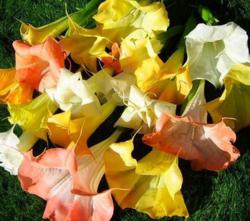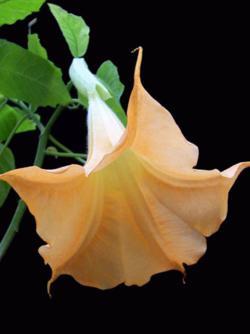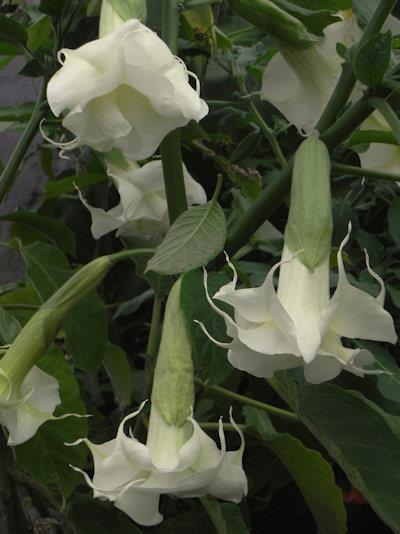Of all the plants in my garden, my apricot-coloured Angel’s Trumpets or brugmansia is by far my favourite. Apart from offering up copious amounts of beautiful, super-sized, flowers, which radiate an unbelievable sweet and heady scent in the evenings, it is really easy to grow and maintain, and it is incredibly hardy. Whenever I entertain; my guests never fail to comment on the beauty and fragrance of my beloved brugmansia – it really is a hit. So much so in fact, that there should be space in every garden for at least one of these breath-taking plants.

Classification: The garden species are most often referred to as Datura; however, these visually attractive plants have been officially reclassified as Brugmansia.
Description: The garden species and cultivars are tall, woody shrubs with soft, velvety leaves. The beautiful, pendulous, trumpet-shaped flowers grow in white, cream, yellow, gold, apricot, pink and mauve. The majority of brugmansias available in local nurseries are variants of Brugmansia candida.
Choosing a location: Brugmansias love full sun – the sunnier and hotter the conditions, the better. It has soft leaves and flowers, so be sure to choose a location that is protected from the frost and wind. Also, since they emit a wonderful aroma during the evening, choose a spot where you can enjoy their fragrance once the sun has gone down.
Growing: Brugmansia are easy to grow from seed. Soak the seeds for 24 hours in hot tap water. Fill pots in humus-rich soil and moisten well. Spread the seed over the soil and cover the pots with clear plastic wrap. Place the pots indoors in a warm, sunny spot and make sure the soil remains moist at all times. The seed will germinate in three to six weeks. Once it has germinated, you can plant it directly into the garden soil during early summer.

Choose a suitable location and dig a hole that is the same depth as the pot. Moisten the hole and set the entire contents of the pot into the soil so that it is level with the surface. Do not try and remove the germinated seed from the soil in the pot and plant it individually in the soil, as it will be exceptionally delicate and easily damaged. Firm over the soil and water well. Keep soil moistened everyday until the plant is well established. Fertilise once a month after planting until the end of summer with a 1:1 mixture of fertiliser to water.
Alternatively, you can grow Brugmansia from a semi-hardwood heel cutting, or a hardwood cutting, that is ideally taken in late summer or early autumn. Once the cuttings have rooted, plant them directly into the garden coupled with plenty of compost and water them well on a regular basis.
Spacing: In ideal conditions, these gorgeous plants generally grow between 3m and 5m tall, and can boast a spread of around 1,5m to 2m in width. Take their adult size into account when planting and determining the spacing around the plant.
Transplanting: Brugmansia do not like to be disturbed, so when you plant them, be sure to choose the right spot. If you really have to move it, then you will need to do it very carefully – keeping as much soil in place around the roots as possible. When it is in its new location, water well daily until the plant shows signs of continued growth.

Toxicity: These plants are poisonous, so they are not really a good choice for gardens where small children roam. The leaves, flowers and seeds all contain powerful tropane alkaloids and considered highly toxic if eaten. The tropane alkaloids do contain treasured medicinal properties used in various medications for asthma and Parkinson’s disease for example, as well as some less useful and even lethal hallucinogenic qualities as well.
Pruning and maintenance: Brugmansias need to be pruned regularly to maintain an ideal branch pattern, and to keep them in tip-top shape and looking their best. The fragrant flowers last for one to seven days, depending on how hot it is – the hotter it is, the shorter the lifespan of the flower. Cut off the dead or dying flowers as often as possible to promote the generation of new flowers.
Pollination and seeds: The flowers are pollinated at night by moths, however, these plants are self-fertile, which means they don’t need a pollinator to make seeds. Leave the old flowers in place if you want seeds to grow more plants, wait until the pods turn brown, and then harvest them for seeds. – Antonella Dési
Readers' Comments Have a comment about this article? Email us now.
I thought you said they were easy to maintain!!! Sounds like a lot of work and fuss to me… - Gaelen
Datura family have a deadly poisonous sap - please check on a botanical site or a poison plant listing and warn your readers! - Anonymous
Stunning article! Just what I was looking for – very good info! Thanks so much! - Erika









